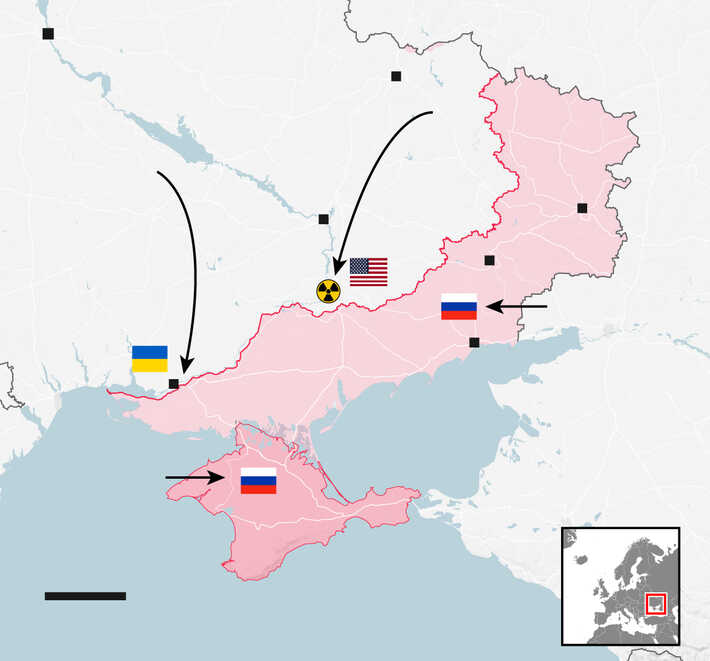
(PCC)As the left struggles to boost their base by ginning up their worn-out “Orange-Man-Bad’ slogan, President Trump is working to bring peace and stop the killing. Trump has once again stepped into the center of global diplomacy, unveiling a controversial seven-point peace plan aimed at ending the Russia-Ukraine war— a conflict that has raged since 2022 and claimed tens of thousands of lives.
Trump’s plan, spearheaded by his envoys and set to be discussed in London this week, promises to bring peace “within a day.” But with its bold concessions to Russia and shaky foundations in international law and regional consensus, many on the left are asking: Will it actually work?
Trump’s 7 Demands for Peace:
Trump’s proposal, as described by sources familiar with the negotiations, includes the following terms:
- Immediate Ceasefire: Both sides would halt hostilities, freezing the conflict along current front lines, effectively recognizing Russia’s territorial gains without formal annexation.
- Withdrawal from Specific Areas: Russia would relinquish control over a portion of the Kherson province and allow Ukraine free access to the Dnieper River’s mouth while retaining most of its territorial conquests.
- NATO Ban for Ukraine: Ukraine would agree never to seek NATO membership, a long-standing Russian demand, though EU accession would remain an option.
- Recognition of Crimea: The U.S. would officially recognize Russia’s annexation of Crimea, which violates international law but reflects a practical shift similar to past American policy on Israel’s West Bank settlements.
- De Facto Recognition of Occupied Territories: While not formally acknowledging the annexation, the U.S. would imply acceptance of Russian control over other parts of Donetsk, Luhansk, Kherson, and Zaporizhzhia.
- Resource Access for U.S. Companies: Ukraine would sign over mineral rights to U.S. firms, a move critics say commodifies Ukrainian sovereignty.
- Restored U.S.-Russia Ties: All U.S. sanctions on Russia would be lifted in exchange for cooperation on global energy policy and a “new relationship” between the superpowers.
The reactions are in, and as usual, it is ‘optimism meets skepticism’ and is always a sure bet for politicians who don’t like to commit.
Trump’s camp argues this deal is pragmatic, not idealistic. His special envoy, Steve Witkoff, will meet Putin in Moscow later this week to push the proposal, while another key figure, General Keith Kellogg, leads discussions in London.
Yet the proposal has already sparked backlash across Europe and Ukraine:
- Ukraine’s Position: President Zelensky has reportedly agreed to the ceasefire in principle, but Ukraine’s constitution prohibits territorial concessions without a public referendum — currently impossible under martial law. Kyiv also remains wary of abandoning NATO hopes, especially without a U.S. security guarantee.
- European Disapproval: France, Britain, and other European powers are deeply concerned about Trump’s willingness to reward aggression and undermine Ukraine’s sovereignty. UK Prime Minister Keir Starmer had recently pledged full NATO support to Ukraine and rejected any deal without robust U.S. backing.
- Putin’s Calculus: Kremlin spokesperson Dmitry Peskov has responded cautiously, warning against “rigid deadlines.” While the plan fulfills several Russian demands, particularly on NATO, it may still fall short of Putin’s long-term goals.
Negotiations always involve strategic risks and rewards. The potential advantages of Trump’s deal lie in its realism: it acknowledges battlefield realities and aims to prevent further bloodshed and escalation with a nuclear-armed adversary. It also positions the U.S. as a direct mediator, potentially sidelining European leadership in the process.
However, the risks are manifold:
- Legitimizing Aggression: Recognizing or tacitly accepting Russia’s land grabs could set a dangerous precedent for future territorial conflicts.
- Weak Security Guarantees: The absence of a U.S. military backstop could leave Ukraine exposed, especially if European forces alone are expected to deter renewed Russian aggression.
- Internal Ukrainian Resistance: With no democratic mechanism currently available to validate territorial concessions, the Ukrainian government risks backlash from its people and military.
The looming question is really the bottom line: Can it work? In theory, Trump’s peace plan could stop the war, at least temporarily. In practice, it demands painful concessions from Ukraine while offering little assurance of long-term security or justice. For many in Europe and Ukraine, it looks less like a peace plan and more like a surrender document.
Even if talks in London produce a preliminary framework, the deeper divisions between Western allies and the lack of Ukrainian constitutional flexibility make any swift resolution unlikely. As a European diplomat said, “At the end of the day, Ukraine will have to leave something on the table,” but how much and at what cost is the question.
Final Word: President Trump is trying to stop the killing, something little men are afraid to even attempt.
https://patriotcommandcenter.org/forum/just-in-7-point-peace-plan-to-end-russia-ukraine-war



